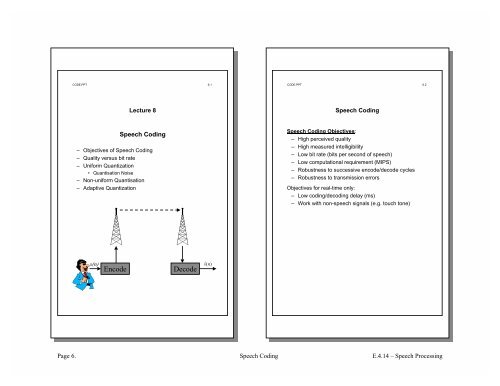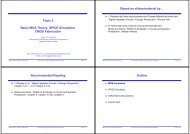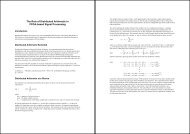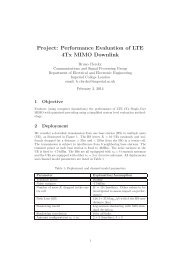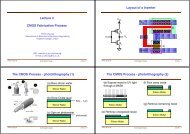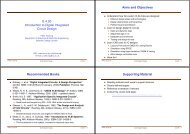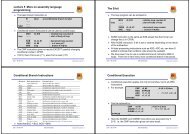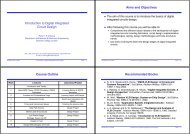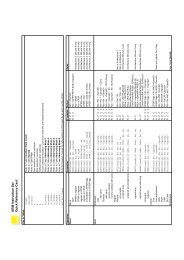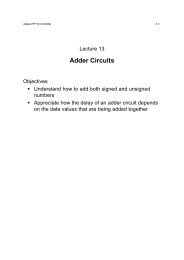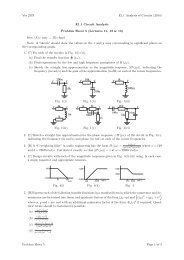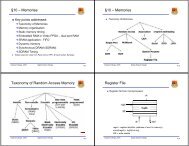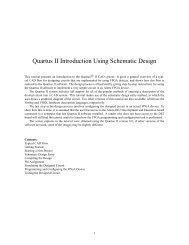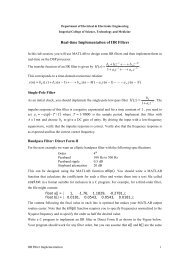Encode Decode
Encode Decode
Encode Decode
You also want an ePaper? Increase the reach of your titles
YUMPU automatically turns print PDFs into web optimized ePapers that Google loves.
CODE.PPT 6.1<br />
CODE.PPT 6.2<br />
Lecture 8<br />
Speech Coding<br />
Speech Coding<br />
– Objectives of Speech Coding<br />
– Quality versus bit rate<br />
– Uniform Quantization<br />
• Quantisation Noise<br />
– Non-uniform Quantisation<br />
– Adaptive Quantization<br />
Speech Coding Objectives:<br />
– High perceived quality<br />
– High measured intelligibility<br />
– Low bit rate (bits per second of speech)<br />
– Low computational requirement (MIPS)<br />
– Robustness to successive encode/decode cycles<br />
– Robustness to transmission errors<br />
Objectives for real-time only:<br />
– Low coding/decoding delay (ms)<br />
– Work with non-speech signals (e.g. touch tone)<br />
s(n)<br />
<strong>Encode</strong><br />
<strong>Decode</strong><br />
sˆ ( n)<br />
Page 6. Speech Coding E.4.14 – Speech Processing
CODE.PPT 6.3<br />
CODE.PPT 6.4<br />
Objective Assessment<br />
Subjective Assessment<br />
– MOS (Mean Opinion Score): a panel of test listeners<br />
rates the quality 1 to 5.<br />
1=bad, 2=poor, 3=fair, 4=good, 5=excellent.<br />
– DRT (Diagnostic Rhyme Test): listeners choose<br />
between pairs of rhyming words (e.g. veal/feel)<br />
– DAM (Diagnostic Acceptability Measure): Trained<br />
listeners judge various factors e.g. muffledness,<br />
buzziness, intelligibility<br />
Quality versus data rate (8kHz sample rate)<br />
Not terribly closely related to subjective quality.<br />
– Segmental SNR: average value of 10log 10 (E speech /E error )<br />
evaluated in 20 ms frames.<br />
No good for coding schemes that can introduce delays as a<br />
one-sample time shift causes a huge decrease in SNR.<br />
– Spectral distances<br />
Based on the power spectrum of the original and codeddecoded<br />
speech signals, P(ω) and Q(ω). denotes the<br />
average over the frequency range 0 … 2π.<br />
Itakura Distance<br />
⎛<br />
log⎜<br />
⎝<br />
P(<br />
ω)<br />
⎞<br />
⎟<br />
−<br />
Q(<br />
ω)<br />
⎠<br />
⎛ P(<br />
ω)<br />
⎞<br />
log⎜<br />
⎟<br />
⎝ Q(<br />
ω)<br />
⎠<br />
music:<br />
5 (excellent)<br />
Mean Opinion Score<br />
4 (good)<br />
3 (fair)<br />
2 (poor)<br />
MELP<br />
1996<br />
LPC10<br />
1984<br />
CELP<br />
1996<br />
GSM2<br />
1994<br />
CELP<br />
1991<br />
LD-CELP<br />
1994<br />
GSM<br />
1987<br />
ADPCM<br />
1984<br />
A/µ law<br />
1972<br />
PCM16<br />
2k 4k 8k 16k 32k 64k 128k<br />
Bits per second<br />
Itakura-Saito Distance<br />
P(<br />
ω)<br />
⎛ P(<br />
ω)<br />
⎞<br />
− log⎜<br />
⎟ −1<br />
Q(<br />
ω)<br />
⎝ Q(<br />
ω)<br />
⎠<br />
Both distances are evaluated over 20 ms frames and<br />
averaged.<br />
If you do LPC analysis on the original and coded speech,<br />
both these distances may also be calculated directly from<br />
the LPC coefficients.<br />
Neither is a true distance metric since they are<br />
asymmetrical:<br />
d P, Q ≠ d Q,<br />
P<br />
( ) ( )<br />
Page 6. Speech Coding E.4.14 – Speech Processing
CODE.PPT 6.5<br />
CODE.PPT 6.6<br />
Quantization Errors<br />
Linear PCM – Pulse Code Modulation<br />
Input &<br />
Output<br />
Signals<br />
Quantisation<br />
Error<br />
Coding/Decoding introduces a quantisation error of ±½w<br />
If input values are uniformly distributed within the bin, the<br />
mean square quantisation error is:<br />
+ ½w<br />
2<br />
x<br />
dx x w<br />
∫ = ⎡ 0289w<br />
w ⎣ ⎢ ⎤<br />
⎥ = ⇒ rms error = .<br />
3w⎦<br />
12<br />
−½w<br />
3<br />
+ ½w<br />
2<br />
−½w<br />
If the quantisation levels are uniformly spaced, w is the<br />
separation between adjacent output values and is called a<br />
Least Significant Bit (LSB)<br />
RMS Quantization Noise is 0.289w = 0.289 LSB<br />
Sine Wave SNR<br />
Full scale sine wave has peak of 0.5 w × 2 n and an rms<br />
value of 0.354 w × 2 n<br />
SNR = 20log<br />
10<br />
⎛rms of maximal sine wave⎞<br />
⎜<br />
⎟<br />
⎝ rms of quantisation noise ⎠<br />
⎛ 0354 . n⎞<br />
= 20log10⎜<br />
× 2 ⎟ = 20log 10( 122 . ) + 20nlog 10( 2)<br />
⎝ 0289 . ⎠<br />
= 176 . + 602 . n dB<br />
Speech SNR<br />
2 n w = 2 n LSB<br />
RMS value of speech or music signal is 10 to 20 dB less<br />
than a sine wave with the same peak amplitude. SNR is 10<br />
to 20 dB worse.<br />
Page 6. Speech Coding E.4.14 – Speech Processing
CODE.PPT 6.7<br />
CODE.PPT 6.8<br />
Non-Uniform Quantization<br />
Non-uniform PCM @ 64 kb/s (f s = 8kHz)<br />
Speech pdf<br />
Uniform<br />
A-law<br />
µ-law<br />
– RMS quantization error = 0.29 ×Quantization step<br />
– Low level signals are commoner than high level ones<br />
– Conclusion:<br />
Make quantization steps closer together at the<br />
commoner signal levels.<br />
Instead of linear coding, use floating point with smaller<br />
intervals for more frequently occuring signal levels:<br />
s = sign bit (1 = +ve)<br />
e = 3-bit exponent<br />
m = 4-bit mantissa Range of values ≈ ±4095<br />
0dB ≈ 2002(µ) or 2017(A) rms<br />
µ-law (US standard):<br />
Bin centres at ±{(m+16½) 2 e – 16½}<br />
Bin widths: 2 e<br />
A-law (European standard):<br />
Bin centres at ±(m+16½) 2 e for e>0 and ±(2m+1) for e=0<br />
Bin widths: 2 e for e>0 and 2 for e=0<br />
For transmission, A-law is XORed with $55 and µ-law with $7F<br />
Performance: MOS=4.3, DRT=95, DAM=73, SNR ≤38dB<br />
For sine waves > –30dB, SNR is almost constant at 38dB<br />
At very low signal levels (–40dB) µ-law≈13 bit, A-law ≈12 bit linear<br />
Page 6. Speech Coding E.4.14 – Speech Processing
CODE.PPT 6.9<br />
CODE.PPT 6.10<br />
Quantising a Gaussian Signal<br />
Adaptive Quantization<br />
a 1 a 2<br />
x 1 x 2 … … x n–1<br />
Input values from a i–1 to a i are converted to x i .<br />
For minimum error we must have a i = ½(x i + x i+1 )<br />
x n<br />
For this range of x, the quantisation error is q(x) = x i – x<br />
The mean square quantisation error is<br />
+∞<br />
∫<br />
n<br />
a<br />
2 2<br />
∑ ∫ ( i )<br />
ai−1<br />
i = 1<br />
i<br />
E = p( x) q ( x) dx = p( x)<br />
x − x dx<br />
−∞<br />
Differentiating w.r.t. x i : ∂E<br />
ai<br />
= px( x x)<br />
dx<br />
∂x<br />
∫ −2<br />
( ) −<br />
a<br />
i<br />
i−1<br />
i<br />
ai<br />
ai<br />
= 2x p( x) dx−2<br />
xp( x)<br />
dx<br />
Find minimum error by setting the derivative to zero<br />
x<br />
i<br />
=<br />
∫<br />
∫<br />
ai<br />
ai−1<br />
ai<br />
ai−1<br />
xp( x)<br />
dx<br />
pxdx ( )<br />
To find optimal {x i }, take an initial guess and iteratively use<br />
the above equation to improve their estimates.<br />
For 15 bins, SNR = 19.7dB<br />
i<br />
∫<br />
∫<br />
ai−1 ai−1<br />
⇔ x i is at the centroid of its bin.<br />
– We want to use smaller steps when the signal level is<br />
small<br />
– We can adjust the step sizes automatically according<br />
to the signal level:<br />
• If almost all samples correspond to the central few<br />
quantisation levels, we must reduce the step size<br />
• If many samples correspond to high quantisation levels,<br />
we must increase the step sizes<br />
Page 6. Speech Coding E.4.14 – Speech Processing
CODE.PPT 6.11<br />
CODE.PPT 6.12<br />
Adaptive Quantization<br />
Scale Factor Updates<br />
5<br />
– Transmitter:<br />
• Divide input signal by k<br />
• Q quantises to 15 levels<br />
• Transmit one of 15 code words<br />
• Update k to new value<br />
– Receiver:<br />
• Inverse quantiser, Q –1 converts received code word to a<br />
number<br />
• Multiply by k to give output value<br />
• Update k to new value<br />
– Update Algorithm<br />
• Decrease k whenever a small code word is<br />
transmitted/received<br />
• Increase k whenever a large code word is<br />
transmitted/received<br />
• Transmitter and Receiver will always have the same<br />
value of k<br />
multiplication factor, M<br />
4.5<br />
4<br />
3.5<br />
3<br />
2.5<br />
2<br />
1.5<br />
1<br />
0.5<br />
-8 -6 -4 -2 0 2<br />
Code word<br />
– k is decreased slightly for “zero” code word (× 0.98)<br />
– k is increased rapidly for extreme code words (× 4.6)<br />
– k is increased slightly for other code words<br />
– Calculation done in log domain:<br />
log( kn) = 097 . log( kn−1)<br />
+ log( M)<br />
“leakage factor” of 0.97 allows recovery from<br />
transmission errors.<br />
Page 6. Speech Coding E.4.14 – Speech Processing
CODE.PPT 6.13<br />
CODE.PPT 6.14<br />
Adaptive Quantization<br />
Lecture 9<br />
Original<br />
Quantised (15 levels)<br />
Adaptive Differential PCM<br />
– Differential Speech Coding<br />
– ADPCM coding<br />
• Prediction Filter<br />
• Filter Adaptation<br />
• Stability Triangle<br />
Error<br />
k<br />
Small signal sections ⇒ small k ⇒ small errors<br />
Page 6. Speech Coding E.4.14 – Speech Processing
CODE.PPT 6.15<br />
CODE.PPT 6.16<br />
Differential PCM (DPCM)<br />
a i<br />
(n)<br />
x(n)<br />
x(n)<br />
+ + Predictor<br />
s(n) +<br />
+ – e(n)<br />
d(n)<br />
Quantiser<br />
+<br />
a^<br />
i<br />
(n)<br />
q(n)<br />
x(n) ^<br />
+ + Predictor<br />
d(n) ^ +<br />
– The encoder contains a complete copy of the decoder<br />
– If no transmission errors, yn !( ) ≡ yn ( ) etc<br />
– Quantisation noise, q(n) = d(n) – e(n)<br />
– Output y(n) = x(n) + d(n) = s(n) – e(n) + d(n) = s(n) + q(n)<br />
Es<br />
Es<br />
Ee<br />
E<br />
SNR = = × = Gp<br />
×<br />
E E E E<br />
q<br />
e<br />
– The predictor is chosen to maximize the prediction<br />
gain: G p = signal energy ÷ prediction error energy.<br />
– E e /E q is the quantiser SNR<br />
– Thea i can be one of:<br />
• fixed constants<br />
• transmitted seperately<br />
• deduced from d(n) and/or y(n)<br />
q<br />
e<br />
q<br />
y(n)<br />
y(n) ^<br />
Adaptive Differential PCM (ADPCM) @ 32 kbit/s<br />
kn ( )<br />
xn ()<br />
b i a i<br />
Scale Factor B + A<br />
–<br />
sn ( ) en ( )<br />
+ Q Q –1 dn ()<br />
÷ × + +<br />
b<br />
^ i a^<br />
i<br />
Q –1<br />
Scale Factor<br />
^kn<br />
( )<br />
+ +<br />
– Quantiser has 15 levels ⇒ 4 bits × 8kHz = 32 kbit/s<br />
– Code 0000 is never transmitted which makes<br />
transmission easier<br />
– Quantisation levels assume e(n) ÷ k(n) is Gaussian<br />
with unit variance. Scale factor k(n) is adjusted to<br />
make this true<br />
– The LPC filter, A, is only of order 2 so that it is easy to<br />
ensure stability.<br />
– The FIR filter, B, is of order 6 and partially makes up<br />
for the short A.<br />
Performance: MOS=4.1, DRT=94, DAM=68, 2 MIPS<br />
×<br />
B<br />
dn ^( )<br />
A<br />
yn ( )<br />
yn ^( )<br />
Page 6. Speech Coding E.4.14 – Speech Processing
CODE.PPT 6.17<br />
CODE.PPT 6.18<br />
Filter Adaptation<br />
Prediction Filter<br />
We adjust the b i to reduce the signal d 2 (n) by moving them<br />
∂<br />
∂<br />
a little in the direction − ( ) =−<br />
∂b d 2<br />
n d n dn ( )<br />
( ) 2 ( )<br />
i<br />
∂bi<br />
Filters:<br />
−1<br />
−2<br />
Az () = az 1 + az 2<br />
We express D in terms of previous values of D:<br />
−1<br />
−2<br />
−3<br />
−4<br />
−5<br />
−6<br />
Bz () = bz 1 + bz 2 + bz 3 + bz 4 + bz 5 + bz 6<br />
Note that ∂ D S Q X S Q A +<br />
= + − = + −<br />
B A ∂B<br />
i<br />
= = z<br />
− 1−<br />
A D<br />
∂ai<br />
∂b<br />
∂D<br />
i<br />
−i<br />
1<br />
z<br />
Note that A(z) and B(z) filters involve only past values<br />
b A D z −i<br />
D ∂dn<br />
( )<br />
=− ≈− ⇒ ≈−dn<br />
( −i)<br />
∂ i 1−<br />
∂bi<br />
Signals:<br />
1 B<br />
Y = D + BD + AY ⇒ Y = + 1−<br />
A D<br />
X BD AY Y D A +<br />
= + = − =<br />
B 1−<br />
A D<br />
D= S+ Q− X = S+ Q− Y+ D ⇒ Y = S+<br />
Q<br />
In the absence of transmission errors, the y(n) output at the<br />
receiver and transmitter will be identical and equal to the<br />
input speech plus the quantisation noise<br />
Hence we want to adjust b i in the direction d(n)d(n-i):<br />
The function sgn() takes the sign of its argument. The<br />
0.996 leakage factor assists in recovery from transmission<br />
errors and prevents b i from exceeding ±2.<br />
( )<br />
b ← 0. 996b + 0. 008× sgn d( n) d( n−i)<br />
i<br />
i<br />
Adjustment of a i is similar but more ad-hoc:<br />
a ← 0.996a<br />
+ 0.012×<br />
sgn<br />
1<br />
2<br />
1<br />
a ← 0.996a<br />
2<br />
+ 0.008×<br />
sgn<br />
( v(<br />
n)<br />
v(<br />
n −1)<br />
)<br />
( v(<br />
n)<br />
v(<br />
n − 2) ) − 0.03a<br />
× sgn( v(<br />
n)<br />
v(<br />
n −1)<br />
)<br />
1<br />
Page 6. Speech Coding E.4.14 – Speech Processing
CODE.PPT 6.19<br />
CODE.PPT 6.20<br />
1−az<br />
Filter Stability<br />
For stability, we make the poles have modulus less than R:<br />
– Real:<br />
1<br />
−1<br />
1<br />
−az<br />
2<br />
1 2 2<br />
( ± + 4 )<br />
has poles at ½ a a a<br />
2 1 1 2 −<br />
2<br />
a + 4a<br />
> 0 and<br />
⇒ a + 4a < 2R±<br />
a<br />
( 1 1 2 4 2 )<br />
( 1 1 2 4 2 )<br />
⎧<br />
⎪<br />
½ a + a + a < R<br />
⎨<br />
⎪½<br />
a − a + a >−R<br />
⎩<br />
1 2 2 1<br />
⇒ a + 4a < a ± 4Ra + 4R ⇒ a < R ± Ra<br />
1 2 2 1 2 1<br />
2<br />
2<br />
2<br />
1<br />
Lecture 10<br />
Code-Excited Linear Prediction (CELP)<br />
– Principles of CELP coding<br />
– Adaptive and Stochastic Codebooks<br />
– Perceptual Error Weighting<br />
– Codebook searching<br />
– Complex:<br />
a + 4a < 0 and a >−R<br />
1 2 2 2<br />
2<br />
a<br />
2<br />
+ Ra<br />
2<br />
2<br />
= R<br />
1<br />
+1 a2 = R − Ra1<br />
a 2<br />
R 2 –R 2<br />
Shading:<br />
|a 2 |
CODE.PPT 6.21<br />
CODE.PPT 6.22<br />
Code Excited Linear Prediction Coding (CELP)<br />
LPC Analysis for CELP<br />
Encoding<br />
– LPC analysis → V(z)<br />
– Define perceptual weighting filter. This permits more<br />
noise at formant frequencies where it will be masked<br />
by the speech<br />
– Synthesise speech using each codebook entry in turn<br />
as the input to V(z)<br />
• Calculate optimum gain to minimise perceptually<br />
weighted error energy in speech frame<br />
• Select codebook entry that gives lowest error<br />
– Transmit LPC parameters and codebook index<br />
Decoding<br />
– Receive LPC parameters and codebook index<br />
– Resynthesise speech using V(z) and codebook entry<br />
Performance:<br />
– 16 kbit/s: MOS=4.2, Delay = 1.5 ms, 19 MIPS<br />
– 8 kbit/s: MOS=4.1, Delay = 35 ms, 25 MIPS<br />
– 2.4 kbit/s: MOS=3.3, Delay = 45 ms, 20 MIPS<br />
– Divide speech up into 30 ms frames (240 samples)<br />
– Multiply by Hamming window<br />
– Perform 10 th order autocorrelation LPC (no<br />
preemphasis)<br />
– Bandwidth expansion: form V(z/0.994) by multiplying a i<br />
by 0.994 i<br />
• Moves all poles in towards the origin of the z plane<br />
• Pole on unit circle moves to a radius of 0.994 giving a<br />
3dB bandwidth of ≈ –ln(r)/π ≈ (1–r)/π = 0.0019;<br />
an unnormalised frequency of 15 Hz @ f s = 8 kHz<br />
• Improves LSP quantisation<br />
• Reduces parameter sensitivity of spectrum<br />
• Avoids chirps due to very sharp formant peaks<br />
– Convert 10 LPC coefficients to 10 LSF frequencies<br />
– Quantise using 4 bits for each of f 2 – f 5 and 3 bits for<br />
each of the others (34 bits in total) from empirically<br />
determined probability density functions.<br />
– Smooth filter transitions by linearly interpolating a new<br />
set of LSP frequencies every ¼ frame.<br />
Page 6. Speech Coding E.4.14 – Speech Processing
CODE.PPT 6.23<br />
CODE.PPT 6.24<br />
LPC Residual<br />
If we were to filter the speech signal by A(z), the inverse<br />
vocal-tract filter, we would obtain the LPC residual:<br />
x(n)<br />
97 samples<br />
We can represent this signal as the sum of a periodic<br />
component and a noise component.<br />
We can represent the periodic component by using a<br />
delayed version of x(n) to predict itself: this is called the<br />
long-term predictor or LTP. Subtracting this delayed<br />
version gives us just the noise component:<br />
x( n)<br />
− 0.76x(<br />
n − 97)<br />
Having removed th periodic component, we search a<br />
codebook of noise signals (a stochastic codebook) for the<br />
best match to the residual excitation signal.<br />
f<br />
g<br />
2k<br />
×<br />
×<br />
x(n)<br />
p(n)<br />
1082 samples: {–1, 0, +1}<br />
Excitation Codebooks<br />
z –m<br />
s(n)<br />
–<br />
+ V(z)<br />
+<br />
+<br />
W(z)<br />
Codebook entry = 7.5 ms<br />
(60 samples)<br />
e(n)<br />
Excitation signal is the sum of 60-sample-long segments<br />
(60 samples = 7.5 ms = ¼ frame) from two sources :<br />
– Long-term predictor (also called Adaptive codebook)<br />
is a delayed version of previous excitation samples<br />
multiplied by a gain, f. The value of m is in the range<br />
20 ≤ m ≤ 147 ⇒ 7 bits (400Hz > f 0 > 54Hz). Some<br />
coders use fractional m for improved resolution at<br />
high frequencies: this requires interpolation.<br />
– Stochastic codebook contains 1082 independent<br />
random values from the set {–1, 0, +1} with<br />
probabilities {0.1, 0. 8, 0.1}. The values of k is in the<br />
range 0 ≤ k ≤ 511 ⇒ 9 bits are needed.<br />
The values of m & f are determined first. Then each<br />
possible value of k is tried to see which gives the lowest<br />
weighted error.<br />
Page 6. Speech Coding E.4.14 – Speech Processing
CODE.PPT 6.25<br />
CODE.PPT 6.26<br />
Perceptual Error Weighting<br />
We want to choose the LTP delay and codebook entry that<br />
gives the best sounding resynthesised speech.<br />
We exploit the phenomenon of masking: a listener will not<br />
notice noise at the formant frequencies because it will be<br />
overwhelmed by the speech energy. We therefore filter the<br />
error signal by:<br />
V ( z / 0.8) A ( z )<br />
W ( z ) =<br />
=<br />
V ( z ) A ( z / 0.8)<br />
This emphasizes the error at noticeable frequencies<br />
dB<br />
0<br />
-10<br />
-20<br />
-30<br />
-40<br />
-50<br />
0 1000 2000 3000 4000 5000<br />
Frequency (Hz)<br />
– Solid line is original V(z)<br />
– Dashed line is bandwidth expanded V(z/0.994) with<br />
slightly lower, broader peaks: more robust.<br />
– Lower solid line is W(z) shifted down a bit to make it<br />
more visible. Errors emphasized between formants.<br />
– Pole-zero plot is W(z). Poles from 1/A(z/0.8); Zeros<br />
from A(z).<br />
Codebook Search<br />
f×p(n)+g×x(n)<br />
We can interchange the subtraction and W(z) and also<br />
separate the excitation signals:<br />
f×p(n)<br />
g×x(n)<br />
H(z)=V(z)W(z)<br />
Here q(n) is the output from the filter H(z) due to both the<br />
LTP signal p(n) and the excitation in previous sub-frames.<br />
y(n) is the output due to the selected portion of the<br />
codebook. If h(n) is the impulse response of H(z) then:<br />
where the sub-frame length, N, is 60 samples (7.5 ms).<br />
Note that even though h(r) is an infinite impulse response,<br />
the summation only goes to n since x(n–r) is zero for r>n.<br />
We want to choose the codebook entry that minimizes<br />
N −1<br />
2<br />
∑<br />
∑( )<br />
∑( )<br />
E = e ( n) = gy( n) + q( n) −t( n)<br />
n=<br />
0<br />
N −1<br />
N −1<br />
n=<br />
0<br />
= gy( n) − u( n) where u( n) = t( n) −q( n)<br />
n=<br />
0<br />
n<br />
V(z)<br />
y(<br />
n)<br />
= ∑ h(<br />
r)<br />
x(<br />
n − r)<br />
r=<br />
0<br />
q(n)<br />
g×y(n)<br />
H(z)=V(z)W(z) +<br />
2<br />
+<br />
+<br />
+<br />
s(n)<br />
+<br />
–<br />
s(n)<br />
W(z)<br />
W(z)<br />
2<br />
e(n)<br />
t(n)<br />
+<br />
for n = 0,1, …,<br />
N −1<br />
–<br />
+<br />
e(n)<br />
Page 6. Speech Coding E.4.14 – Speech Processing
CODE.PPT 6.27<br />
CODE.PPT 6.28<br />
Gain Optimization<br />
2k<br />
t(n)<br />
W(z)<br />
+<br />
s(n)<br />
x k<br />
(n)<br />
g<br />
g×y(n)<br />
H(z)=V(z)W(z)<br />
+<br />
×<br />
We can find the optimum g by setting ∂E<br />
to zero:<br />
N<br />
N<br />
∂g<br />
2<br />
2<br />
E = e ( n) = gy( n) −u( n)<br />
∑<br />
n= 0 n=<br />
0<br />
∑( )<br />
∂E<br />
2<br />
⇒ 0 = ½ = ∑ynen ( ) ( ) = ∑gy ( n) −∑ynun<br />
( ) ( )<br />
∂g<br />
⇒ g =<br />
opt<br />
∑<br />
n<br />
ynun ( ) ( )<br />
∑<br />
n<br />
y<br />
n n n<br />
2<br />
( n)<br />
Substituting this in the expression for E gives:<br />
∑<br />
u(n)<br />
–<br />
q(n)<br />
e(n)<br />
2 2 2 2<br />
( opt ( ) ( )) ∑( opt ( ) 2 opt ( ) ( ) ( ))<br />
Eopt<br />
= g yn − un = g y n − g unyn + u n<br />
n<br />
n<br />
2 2 2<br />
= gopt<br />
∑y ( n) − 2gopt<br />
∑u( n) y( n) + ∑u ( n)<br />
n<br />
n<br />
n<br />
2<br />
⎛ ⎞<br />
⎜∑unyn<br />
( ) ( )<br />
⎟<br />
2 ⎝ n ⎠<br />
= ∑u<br />
( n)<br />
−<br />
2<br />
n ∑ y ( n)<br />
n<br />
+<br />
+<br />
–<br />
Energy Calculation<br />
We need to find the k that minimizes:<br />
⎛<br />
⎜<br />
2 ⎝<br />
E = u ( n)<br />
−<br />
opt<br />
Note that for n≥2<br />
x ( n)<br />
= x + 1(<br />
n − 2)<br />
Hence<br />
∑<br />
k<br />
n<br />
k<br />
y ( n)<br />
=<br />
k<br />
⎞<br />
uny ( ) k ( n)<br />
⎟<br />
⎠<br />
2<br />
y ( n)<br />
∑<br />
n<br />
∑<br />
n<br />
k<br />
where y ( n) = h( j) x ( n−<br />
j)<br />
Thus we can derive y k () from y k+1 () with very little extra<br />
computation. We only need to perform the full calculation<br />
for the last codebook entry. Note too that the multiplication<br />
h(n)x k (0) is particularly simple since x k (0) ∈ {–1,0,+1}.<br />
No divisions are needed for comparing energies since:<br />
⎛<br />
⎜C<br />
−<br />
A<br />
⎝ B<br />
n<br />
∑<br />
r=<br />
0<br />
⎞ ⎛<br />
⎟ < ⎜ C −<br />
A<br />
⎠ ⎝ B<br />
2<br />
h(<br />
r)<br />
x ( n − r)<br />
2k<br />
= h(<br />
n)<br />
x (0) + h(<br />
n −1)<br />
x (1) +<br />
k<br />
= h(<br />
n)<br />
x (0) + h(<br />
n −1)<br />
x (1) + y<br />
k<br />
k<br />
k<br />
n−2<br />
∑<br />
r=<br />
0<br />
x k<br />
(n)<br />
n<br />
∑<br />
j = 0<br />
x k+1<br />
(n)<br />
h(<br />
r)<br />
x<br />
k+<br />
1<br />
( n − 2)<br />
⎞<br />
⎟ ⇔ AB < AB<br />
⎠<br />
2 2 2 2 1 2 1 2 1 2 2 2 2 2 1 2<br />
k<br />
k<br />
k + 1<br />
k<br />
( n − 2 − r)<br />
Page 6. Speech Coding E.4.14 – Speech Processing
CODE.PPT 6.29<br />
f<br />
g<br />
2k<br />
×<br />
×<br />
x(n)<br />
4.8 kbit/s CELP Encoding<br />
p(n)<br />
z –m<br />
t(n)<br />
–<br />
e(n)<br />
+ H(z)<br />
+<br />
+<br />
Codebook entry = 7.5 ms<br />
(60 samples)<br />
– Do LPC analysis for 30 ms frame (34 bits transmitted)<br />
– For each ¼-frame segment (7.5 ms) do the following:<br />
• Calculate q(n) as the output of H(z) due to the excitation<br />
from previous sub-frames.<br />
• Search for the optimal LTP delay, m (4 × 7 bits<br />
transmitted per frame) and determine the optimal LTP<br />
gain, f (4 × 5 bits transmitted)<br />
• Recalculate q(n) to equal the output of H(z) when driven<br />
by the sum of the selected LTP signal as well as the<br />
inputs from previous frames<br />
• Search for the optimal stochastic codebook entry, k (4 ×<br />
9 bits transmitted) and gain, g (4 × 5 bits transmitted)<br />
– Calculate a Hamming error correction code to protect<br />
high-order bits of m (5 bits transmitted)<br />
– Allow one bit for future expansion of the standard<br />
Total = 144 bits per 30 ms frame<br />
Decoding is the same as encoding but without W(z)<br />
Page 6. Speech Coding E.4.14 – Speech Processing


